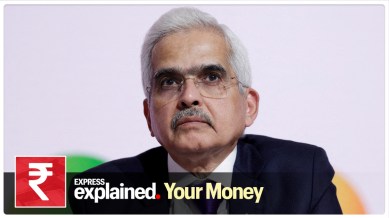Markets crash: Causes, what retail investors should do
While the Sensex-Nifty fall came as a rude shock, experts say short-term volatility should not worry retail investors. Here's what you need to know.

The stock market showed resilience in 2023, with benchmark indices Sensex and Nifty gaining around 20%. This rally, despite geopolitical tensions and slower global growth, was driven by strong macroeconomic fundamentals, improved corporate sector performance, the expectation of rate cuts by the US Federal Reserve in 2024, and higher inflows from foreign portfolio investors (FPI). This year also started on a positive note, with the BSE’s Sensex rising above the 73,000 mark and the NSE’s Nifty breaching the 22,000 mark for the first time.
monthly limit of free stories.
with an Express account.
However, the rally did not last long. Domestic equity indices plummeted over 2% on January 17 and the next day saw another 0.45% drop. The fall, the sharpest since June 2022, was driven by several factors — fears of rate cut delay by the Fed, weaker quarterly result announcement by HDFC Bank, a rise in the US bond yields, profit booking and FPI outflows.
While the fall came as a rude shock, experts say short-term volatility should not worry retail investors.
The big plunge
On January 17, the BSE’s 30-share Sensex fell 1,628.01 points, or 2.23 %, to close at 71,500.76. Nifty 50 lost 460.35 points, or 2.09%, to end at 21,571.95.
The sell-off continued on January 18, as the Sensex dropped 313.9 points, or 0.44%, to finish at 71,186.86 and the Nifty declined 109.7 points, or 0.51% to settle at 21,462.25.
“At elevated valuations, the market needs only a trigger for a sell-off, and on January 17, this trigger came in the form of HDFC Bank’s worse-than-expected results,” said VK Vijayakumar, Chief Investment Strategist, Geojit Financial Services.
HDFC Bank contributed to around 60% of the fall in the Sensex and 30% in the Nifty 50 on Wednesday.
Fed in no hurry to cut rates, US yield rises
The selloff in the benchmark indices was seen after Christopher J Waller, Governor, Federal Reserve System, on Tuesday suggested there wasn’t much urgency for a rate cut, which was earlier expected from March. “The global negativity will come from the rising bond yields in the US (the 10-year yield is at 4.04%) responding to concerns that the sharp rate cuts expected from the Fed this year may not materialise,” said Vijayakumar.
Foreign investors tend to stay away from India when the US yield rises and stocks become overvalued.
Concerns over HDFC Bank
In the quarter ended December 2023, HDFC Bank reported a 33.5% increase in its standalone net profit, at Rs 16,370 crore. According to a note by JM Financial, the growth was aided by a lower effective tax rate during the quarter.
While its net interest margin (NIM) — the difference between the interest income earned and the interest paid — stood at 3.4 % on total assets, there are concerns about this going forward.
“A key aspect was that margins were flat QoQ at 3.4%. Improvement in NIM is critical for re-rating of the stock,” said Suresh Ganapathy, Managing Director, Head of Financial Services Research, Macquarie Capital Securities (India) Pvt. Ltd.
Post the announcement of results on Tuesday, the bank’s Chief Financial Officer Srinivasan Vaidyanathan told reporters that the increase in risk weights on consumer loans by the RBI will have an impact of 97 basis points (bps) on the capital adequacy ratio — the ratio of a bank’s capital in relation to its risk-weighted assets and current liabilities.
Markets being overvalued
Analysts say the market was ripe for a correction as it had run up very fast in the last few weeks.
The mid and small-cap space is overvalued and is sustaining at high levels only by the high liquidity in the system. Some profit booking and moving the money to fixed income can be considered now, said an analyst.
What investors should note
In a January 17 speech at Davos, RBI Governor Shaktikanta Das said that globally, markets have scaled new highs, raising concerns they might be running ahead of themselves.
He said that certain hard facts have to be kept in mind: global growth is slowing down; the geopolitical situation remains fragile; geo-economic fragmentation remains unabated, undermining global trade; and daunting climate-related challenges are holding their ground.
Analysts said such challenges will impact global as well as domestic markets. Retail investors, who have become major participants in the stock market through mutual funds and direct investments, need to tread carefully and should not be swayed by either a rally or a crash, analysts said.
“My suggestion would be not to look at the short-term volatility. If you want to invest in the markets, come with a vision of five years. Also, do not time the markets,” Anand Rathi Group’s Founder and Chairman, Anand Rathi, said.
According to Jaideep Hansraj, Managing Director, Kotak Securities, common retail investors should continue investing in SIPs (systematic investment plan) instead of trying to time the market. If markets fall further, they may increase their investment in SIPs, he said.